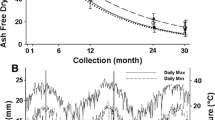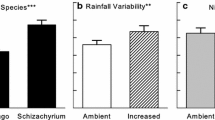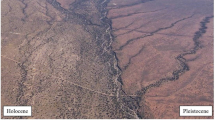Abstract
Decomposition models typically under-predict decomposition relative to observed rates in drylands. This discrepancy indicates a significant gap in our mechanistic understanding of carbon and nutrient cycling in these systems. Recent research suggests that certain drivers of decomposition that are often not explicitly incorporated into models (for example, photodegradation and soil–litter mixing; SLM) may be important in drylands, and their exclusion may, in part, be responsible for model under-predictions. To assess the role of SLM, litterbags were deployed in the Chihuahuan Desert and interrelationships between vegetation structure, SLM, and rates of decomposition were quantified. Vegetation structure was manipulated to simulate losses of grass cover from livestock grazing and shrub encroachment. We hypothesized that reductions in grass cover would promote SLM and accelerate mass loss by improving conditions for microbial decomposition. Litter mass decreased exponentially, with the greatest losses occurring in concert with summer monsoons. There were no differences in decay constants among grass cover treatments. A significant, positive relationship between mass loss and SLM was observed, but contrary to expectations SLM was independent of grass cover. This suggests that processes operating at finer spatial scales than those in our grass removal treatments were influencing SLM. Shifts in litter lipid composition suggest increased bacterial contribution to decomposition through time. SLM, which is seldom included as a variable controlling decomposition in statistical or mechanistic models, was a strong driver of decomposition. Results are discussed in the context of other known drivers of decomposition in drylands (for example, UV radiation and climate) and more mesic systems.







Similar content being viewed by others
References
Adair EC, Hobbie SE, Hobbie RK. 2010. Single-pool exponential decomposition models: potential pitfalls in their use in ecological studies. Ecology 91:1225–36.
Aerts R. 1997. Climate, leaf litter chemistry and leaf litter decomposition in terrestrial ecosystems: a triangular relationship. Oikos 79:439–49.
Aerts R, Logtestijn R, Karlsson P. 2006. Nitrogen supply differentially affects litter decomposition rates and nitrogen dynamics of sub-arctic bog species. Oecologia 146:652–8.
Akaike H. 1974. A new look at the statistical model identification. IEEE Trans Autom Control 19:716–23.
Asner G, Archer S. 2010. Livestock and the global carbon cycle. In: Steinfeld HMH, Schneider F, Neville LE, Eds. Livestock in a changing landscape: volume 1. Drivers, consequences and responses. Washington, DC: Island Press. p 69–82.
Austin AT, Ballaré CL. 2010. Dual role of lignin in plant litter decomposition in terrestrial ecosystems. Proc Natl Acad Sci 107:4618–22.
Austin AT, Vivanco L. 2006. Plant litter decomposition in a semi-arid ecosystem controlled by photodegradation. Nature 442:555–8.
Bahre CJ, Shelton ML. 1996. Rangeland destruction: cattle and drought in southeastern Arizona at the turn of the century. Journal of the Southwest 38:1–22.
Barnes PW, Throop HL, Hewins DB, Abbene ML, Archer SR. 2012. Soil coverage reduces photodegradation and promotes the development of soil-microbial films on dryland leaf litter. Ecosystems 15:311–21.
Barron-Gafford GA, Scott RL, Jenerette GD, Hamerlynck EP, Huxman TE. 2011. Temperature and precipitation controls over leaf- and ecosystem-level CO2 flux along a woody plant encroachment gradient. Glob Change Biol 18:1389–400.
Berg B, Laskowski R, Bjorn B, Ryszard L. 2005. Changes in substrate composition and rate-regulating factors during decomposition. Advances in Ecological Research. Waltham, MA: Academic Press. pp 101–55.
Bergametti G, Gillette DA. 2010. Aeolian sediment fluxes measured over various plant/soil complexes in the Chihuahuan Desert. J Geophys Res 115. doi:10.1029/2009jf001543.
Blair JM, Crossley DA Jr. 1988. Litter decomposition, nitrogen dynamics and litter microarthropods in a southern Appalachian hardwood forest 8 years following clearcutting. J Appl Ecol 25:683–98.
Bligh EG, Dyer WG. 1956. A rapid method of total lipid extraction and purification. Canadian Journal of Biochemistry and Physiology 37:911–17.
Brandt L, King J, Hobbie S, Milchunas D, Sinsabaugh R. 2010. The role of photodegradation in surface litter decomposition across a grassland ecosystem precipitation gradient. Ecosystems 13:765–81.
Breshears DD, Whicker JJ, Johansen MP, Pinder JE. 2003. Wind and water erosion and transport in semi-arid shrubland, grassland and forest ecosystems: quantifying dominance of horizontal wind-driven transport. Earth Surf Proc Land 28:1189–209.
Buffington LC, Herbel CH. 1965. Vegetational changes on a semidesert grassland range from 1858 to 1963. Ecol Monogr 35:139–64.
Collins SL, Sinsabaugh RL, Crenshaw C, Green L, Porras-Alfaro A, Stursova M, Zeglin LH. 2008. Pulse dynamics and microbial processes in aridland ecosystems. J Ecol 96:413–20.
Dobbs FC, Findlay RH. 1993. Analysis of microbial lipids to determine biomass and detect the response of sedimentary microorganisms to disturbance. In: Kemp PF, Sherr BF, Sherr EB, Cole JJ, Eds. Handbook of methods in aquatic microbial ecology. Chelsea, MI: Lewis Publishers. p 347–58.
Field CB, Behrenfeld MJ, Randerson JT, Falkowski P. 1998. Primary production of the biosphere: Integrating terrestrial and oceanic components. Science 281:237–40.
Field JP, Belnap J, Breshears DD, Neff JC, Okin GS, Whicker JJ, Painter TH, Ravi S, Reheis MC, Reynolds RL. 2009a. The ecology of dust. Front Ecol Environ 8:423–30.
Field JP, Breshears DD, Whicker JJ. 2009b. Toward a more holistic perspective of soil erosion: why aeolian research needs to explicitly consider fluvial processes and interactions. Aeolian Res 1:9–17.
Findlay RH, Dobbs FC. 1993. Quantitative description of microbial communities using lipid analysis. In: Kemp PF, Sherr BF, Sherr EB, Cole JJ, Eds. Handbook of methods in aquatic microbial ecology. Chelsea, MI: Lewis Publishers. p 271–84.
Fredrickson E, Havstad KM, Estell R. 1998. Perspectives on desertification: south-western United States. J Arid Environ 39:191–207.
Gibbens RP, McNeely RP, Havstad KM, Beck RF, Nolen B. 2005. Vegetation changes in the Jornada Basin from 1858 to 1998. J Arid Environ 61:651–68.
Gillette DA, Pitchford AM. 2004. Sand flux in the northern Chihuahuan desert, New Mexico, USA, and the influence of mesquite-dominated landscapes. J Geophys Res 109. doi:10.1029/2003jf000031.
Harmon ME, Nadelhoffer KJ, Blair JM. 1999. Measuring decomposition, nutrient turnover, and stores in plant litter. In: Robrtson GP, Coleman DC, Bledsoe CS, Sollins P, Eds. Standard soil methods for long-term ecological research. Cary, NC: Oxford University Press. p 202–40.
Harmon ME, Silver WL, Fasth B, Chen H, Burke IC, Parton WJ, Hart SC, Currie WS. 2009. Long-term patterns of mass loss during the decomposition of leaf and fine root litter: an intersite comparison. Glob Change Biol 15:1320–38.
Harwood JL, Russel NJ. 1984. Lipids in plants and microbes. Boston, MA: George, Allen, & Unwin Ltd. p 162.
Helm PJ, Breed CS. 1999. Instrumented field studies of sediment transport by wind. In: Breed CS, Reheis MC, Eds. Desert winds: monitoring wind-related surface processes in Arizona, New Mexico and California. US Geological Survey Professional Paper 1598. Washington (DC): US Geological Survey. pp. 31–51.
Hobbie SE. 1996. Temperature and plant species control over litter decomposition in Alaskan tundra. Ecol Monogr 66:503–22.
Hobbie SE, Schimel JP, Trumbore SE, Randerson JR. 2000. Controls over carbon storage and turnover in high-latitude soils. Glob Change Biol 6:196–210.
King J, Brandt L, Adair E. 2012. Shedding light on plant litter decomposition: advances, implications and new directions in understanding the role of photodegradation. Biogeochemistry 1–25.
Kirschbaum MUF, Lambie SM, Zhou H. 2011. No UV enhancement of litter decomposition observed on dry samples under controlled laboratory conditions. Soil Biol Biochem 43:1300–7.
Li J, Okin G, Alvarez L, Epstein H. 2007. Quantitative effects of vegetation cover on wind erosion and soil nutrient loss in a desert grassland of southern New Mexico, USA. Biogeochemistry 85:317–32.
MEA. 2005. Millennium ecosystem assessment: ecosystems and human well-being: desertification synthesis. Washington, DC: World Resource Institute.
Meentemeyer V. 1978. Macroclimate and lignin control of litter decomposition rates. Ecology 59:465–72.
Milchunas DG, Lauenroth WK. 1993. Quantitative effects of grazing on vegetation and soils over a global range of environments. Ecol Monogr 63:327–66.
Monger HC. 2006. Soil development in the Jornada Basin. In: Havstad KM, Huenneke LF, Schlesinger WH, Eds. Structure and function of a Chihuahuan Desert ecosystem: the Jornada Basin long-term ecological research site. New York, NY: Oxford University Press. p 81–106.
Moorhead DL, Reynolds JF. 1991. A general model of litter decomposition in the northern Chihuahuan Desert. Ecol Model 56:197–219.
Neher DA, Barbercheck ME, El-Allaf SM, Anas O. 2003. Effects of disturbance and ecosystem on decomposition. Appl Soil Ecol 23:165–79.
Neilson RP. 1986. High resolution climatic analysis and southwest biogeography. Science 232:27–34.
Okin GS. 2005. Dependence of wind erosion and dust emission on surface heterogeneity: stochastic modeling. J Geophys Res 110. doi:10.1029/2004jd005288.
Okin GS. 2008. A new model of wind erosion in the presence of vegetation. J Geophys Res 113. doi:10.1029/2007jf000758.
Okin GS, Gillette DA. 2001. Distribution of vegetation in wind-dominated landscapes: implications for wind erosion modeling and landscape processes. J Geophys Res 106:9673–83.
Olson JS. 1963. Energy storage and the balance of producers and decomposers in ecological systems. Ecology 44:322–31.
Parton W, Silver WL, Burke IC, Grassens L, Harmon ME, Currie WS, King JY, Adair EC, Brandt LA, Hart SC, Fasth B. 2007. Global-scale similarities in nitrogen release patterns during long-term decomposition. Science 315:361–4.
Paul ND, Gwynn-Jones D. 2003. Ecological roles of solar UV radiation: towards an integrated approach. Trends Ecol Evol 18:48–55.
Reynolds JF, Smith DMS, Lambin EF, Turner BLII, Mortimore M, Batterbury SPJ, Downing TE, Dowlatabadi H, Fernandez RJ, Herrick JE, Huber-Sannwald E, Jiang H, Leemans R, Lynam T, Maestre FT, Ayarza M, Walker B. 2007. Global desertification: building a science for dryland development. Science 316:847–51.
Sasser M. 1990. Identification of bacteria by gas chromatography of cellular fatty acids. Newark, DE: MIDI Inc.
Shen W, Lin Y, Jenerette G, Wu J. 2011. Blowing litter across a landscape: effects on ecosystem nutrient flux and implications for landscape management. Landsc Ecol 26:629–44.
Throop HL, Archer SR. 2007. Interrelationships among shrub encroachment, land management, and litter decomposition in a semidesert grassland. Ecol Appl 17:1809–23.
Throop HL, Archer SR. 2009. Resolving the dryland decomposition conundrum: Some new perspectives on potential drivers. Prog Bot 70:171–94.
Throop HL, Reichmann LG, Sala OE, Archer SR. 2012. Response of dominant grass and shrub species to water manipulation: an ecophysiological basis for shrub invasion in a Chihuahuan Desert Grassland. Oecologia 169:373–83.
Turner BLI, Clark WC, Kates RW, Richards JF, Mathews JT, Meyers WB. 1990. The earth as transformed by human action. New York, NY: Cambridge University Press.
Uselman SM, Snyder KA, Blank RR, Jones TJ. 2011. UVB exposure does not accelerate rates of litter decomposition in a semi-arid riparian ecosystem. Soil Biol Biochem 43:1254–65.
Vestal JR, White DC. 1989. Lipid analysis in microbial ecology. Bioscience 39:535–41.
Wainwright J. 2006. Climate and climatological variations in the Jornada Basin. In: Havstad K, Huenneke LF, Schlesinger W, Eds. Structure and function of a Chihuahuan Desert ecosystem. Oxford: New York, NY. p 44–80.
White DC, Davis WM, Nickels JS, King JD, Bobbie RJ. 1979. Determination of the sedimentary microbial biomass by extractible lipid phosphate. Oecologia 40:51–62.
White DC, Stair JO, Ringelberg DB. 1996. Quantitative comparisons of in situ microbial biodiversity by signature biomarker analysis. J Ind Microbiol Biotechnol 17:185–96.
Whitford WG. 2002. Ecology of desert systems. New York, NY: Academic Press.
Whitford WG, Meentemeyer V, Seastedt TR, Cromack K Jr, Crossley DA Jr, Santos P, Todd RL, Waide JB. 1981. Exceptions to the AET model: deserts and clear-cut forest. Ecology 62:275–7.
Wilkinson SC, Anderson JM, Scardelis SP, Tisiafouli M, Taylor A, Wolters V. 2002. PLFA profiles of microbial communities in decomposing conifer litters subject to moisture stress. Soil Biol Biochem 34:189–200.
Xu X, Hirata E, Enoki T, Tokashiki Y. 2004. Leaf litter decomposition and nutrient dynamics in a subtropical forest after typhoon disturbance. Plant Ecol 173:161–70.
Zepp RG, Callaghan TV, Erickson DJ. 1998. Effects of enhanced solar ultraviolet radiation on biogeochemical cycles. J Photochem Photobiol 46:69–82.
Acknowledgments
We appreciate thoughtful comments by two reviewers. We appreciate laboratory and field assistance from L. Ebbs, J. Fitzgerald, T. Clawson, J. Nelson, J. Ahmed, and N. Nahid. We thank J.A. Perez for statistical consultation and field assistance, and W.G. Whitford, B. Bestelmeyer, and J. Anderson for helpful discussions. This work was supported by an NSF collaborative grant (DEB 0815808 to HT, DEB 0816162 to SA, DEB 0814461 to RM) and the Jornada Basin LTER (NSF DEB 0618210).
Author information
Authors and Affiliations
Corresponding author
Additional information
Author Contributions: DH, HT, SA, and GO conceived of and designed the study; DH and RM performed the research and analyzed the data; DH, HT, SA, and RM wrote the paper.
Rights and permissions
About this article
Cite this article
Hewins, D.B., Archer, S.R., Okin, G.S. et al. Soil–Litter Mixing Accelerates Decomposition in a Chihuahuan Desert Grassland. Ecosystems 16, 183–195 (2013). https://doi.org/10.1007/s10021-012-9604-5
Received:
Accepted:
Published:
Issue Date:
DOI: https://doi.org/10.1007/s10021-012-9604-5




